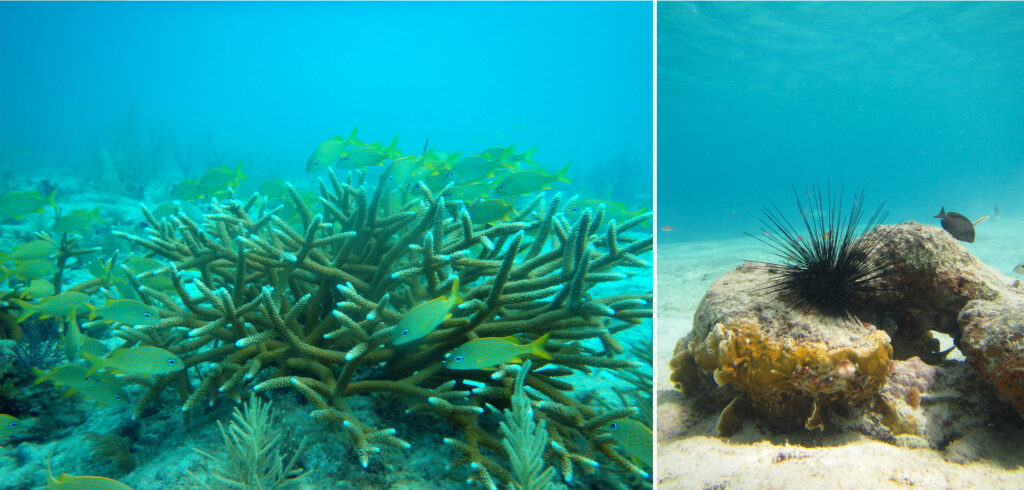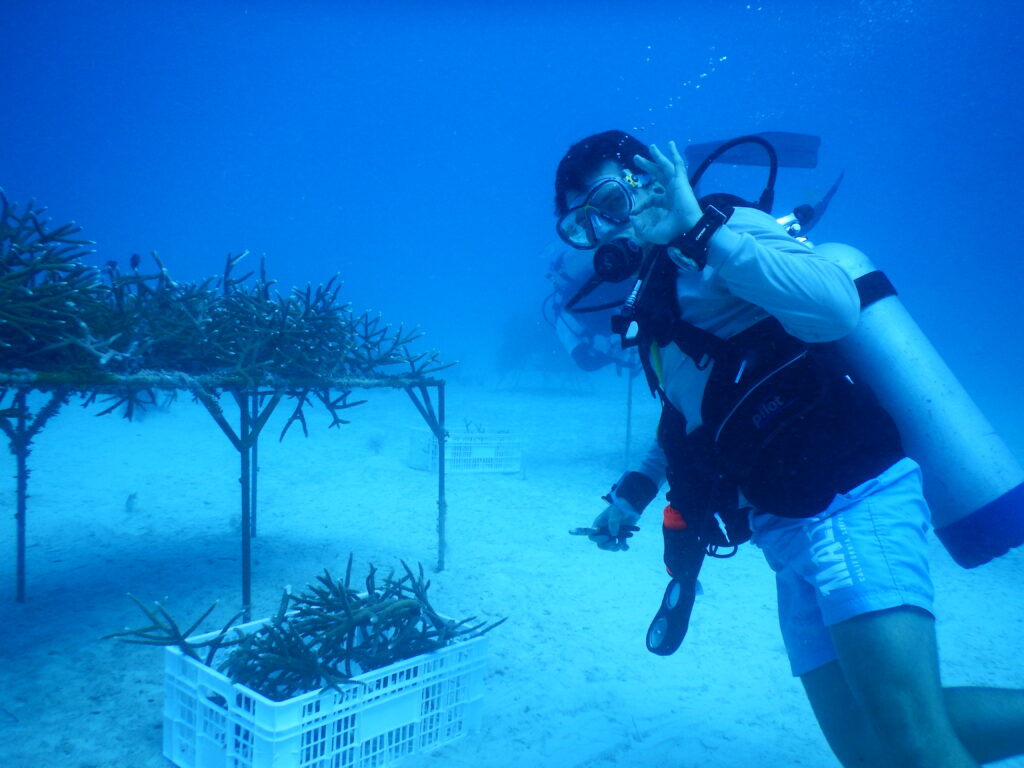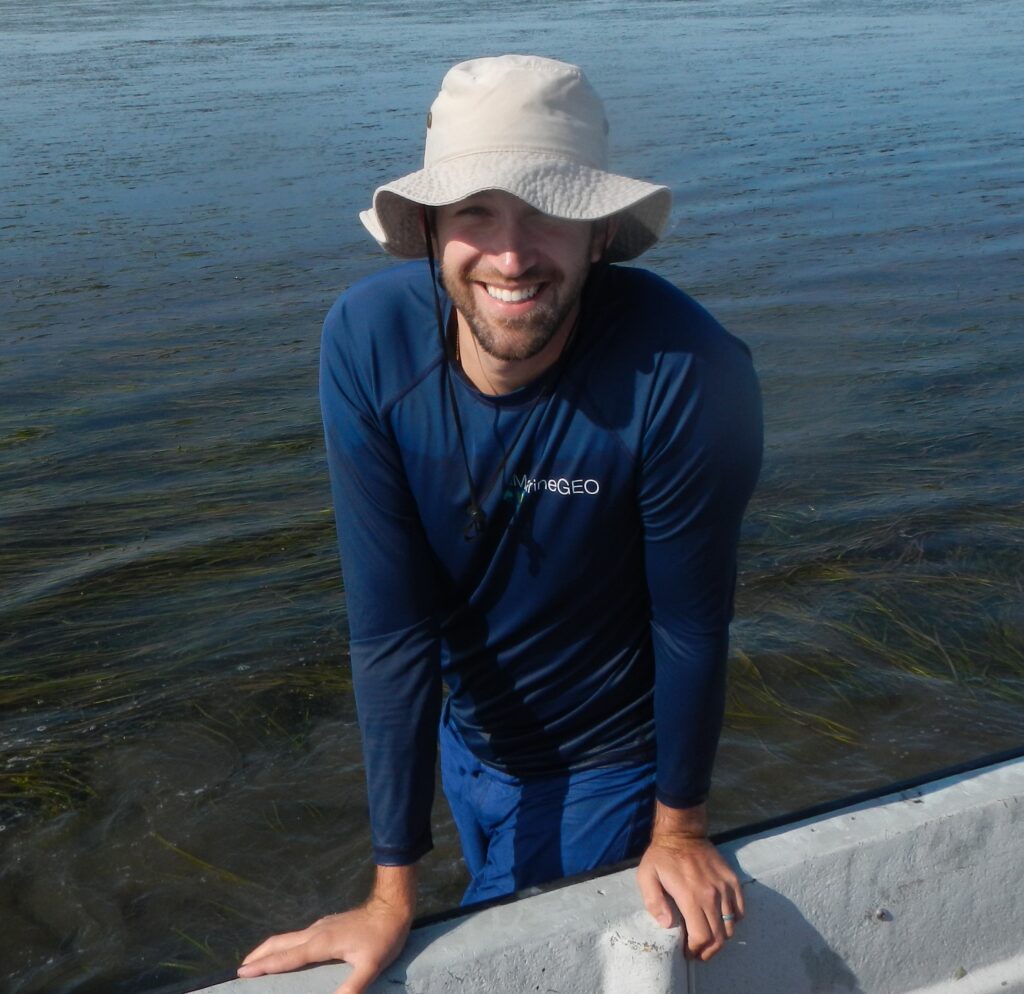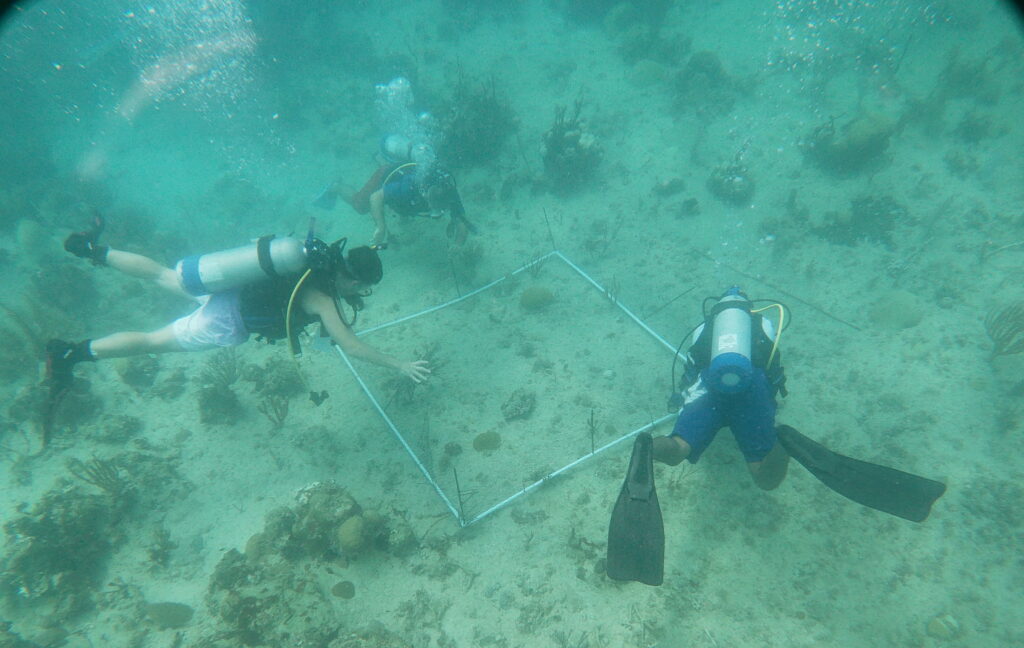by Deva Holliman

Left: Staghorn coral, Acropora cervicornis (Credit: Florida Fish and Wildlife / CC license). Right: Long-spined urchin, Diadema antillarum, perched on a rock (Credit: Via Tsuji / CC license).
As coral reefs around the world deteriorate at frightening rates, many scientists are searching for ways to rebuild these valuable ecosystems. According to a recent study published in the Journal of Experimental Marine Biology and Ecology, the key to successful coral restoration may be found amidst a bunch of hungry sea urchins.
“Coral reefs are in incredible decline, largely as a consequence of human activities,” said Jonathan Lefcheck, a scientist with the Smithsonian Environmental Research Center (SERC) who helped coordinate the study. Threats like warming temperatures, acidifying oceans, and virulent coral diseases have caused worldwide coral populations to rapidly dwindle.
In addition, large swaths of brownish-green macroalgae have started to overtake many coral reefs. Algae prevent sunlight from reaching the photosynthetic coral polyps, eventually causing the coral to die. Coral reef communities are constantly fighting for dominance over algae. But when the coral becomes weakened, it may no longer be able to stand its ground—and the wealth of marine life that normally depends on coral reefs also suffers.

Iván Cano, graduate student at Universidade da Coruña in Coruña, Spain, tends a coral plot. (Credit: Aldo Croquer)
“Coral reefs are biodiversity hotspots, with thousands of species depending directly on them,” said lead author Iván Cano, graduate student at the Universidade da Coruña in Coruña, Spain. “In fact, humans obtain direct services from these ecosystems, such as food and coastal protection. Reefs are rapidly declining due to various local and global stressors, and the consequences that may arise from their loss are barely understood. Beyond these factors, coral reefs are intrinsically beautiful and valuable and deserve our best effort to protect them.”
Nursing Corals Back to Life
But with a little help from scientists, coral reefs can be rebuilt, and their vibrant ecological communities can return. The practice of coral restoration—or, more aptly, “coral gardening”—has become become increasingly popular in recent years, as more people recognize that corals will be unable to recover without human intervention.
The coral restoration process begins with propagation. It’s roughly the same principle as cutting off the stem of a houseplant to grow another plant. Coral propagation involves cutting off small fragments of living coral and allowing them to grow into bigger individuals. Starting with a hearty and fast-growing coral species, the gardeners create structures that will encourage other species, both coral and otherwise, to recruit. Soon enough, an entire coral reef community can come back to life.

Aldo Croquer, coral manager at The Nature Conservancy in the Dominican Republic. (Credit: Aldo Croquer)
Aldo Croquer, coral manager at The Nature Conservancy (TNC) in the Dominican Republic, hoped to add another ingredient to help coral restorations in their battle with algae: herbivores. Or, more specifically, algae-eating sea urchins.
“Corals and algae don’t get along with each other very well,” said Croquer. “The idea behind our study is that by improving herbivory, we could help get rid of some algae and eventually provide some better chances to coral to survive on their own.”
Sea urchins are crucial herbivores on coral reefs. In fact, the long-spined urchin (Diadema antillarum) used to be one of the most common herbivores in the Caribbean. However, after a deadly disease struck in 1983, the urchin population almost entirely disappeared.

Jonathan Lefcheck, SERC researcher and coordinating scientist for the Smithsonian Marine Global Earth Observatory. (Credit: Jonathan Lefcheck)
Croquer predicted that the co-restoration of coral and these urchins could prove beneficial for both species. The urchins would keep algae from overtaking the corals. In turn, the corals would provide the urchins a reliable food source.
“If we build a little ecology into the restoration process, we could achieve a greater success than might be seen in other places that aren’t thinking about herbivory,” said Lefcheck, whom Croquer recruited to help with the study.
Putting Sea Urchins to the Test

The researchers install a cage on one of the coral restoration plots, to ensure the urchins cannot escape. (Credit: Rita Sellares)
To better understand the benefits of co-restoring sea urchins and coral, Croquer and his team of researchers collaborated with the Fundación Dominicana de Estudios Marinos (FUNDEMAR) to arrange underwater plots of staghorn coral (Acropora cervicornis) in the Southeastern Reefs Marine Sanctuary of the Dominican Republic.
In addition to the coral fragments, they placed a specific number of sea urchins in each plot. To prevent the urchins from escaping, the researchers covered each plot with a mesh cage.
Croquer’s team maintained the plots for three months, keeping tabs on coral growth and survivorship, algae, and predation.
In the plots with sea urchins, the researchers observed much less algae, and a much greater amount of living coral tissue—suggesting that the urchins improved the coral’s ability to survive and grow.
The researchers also found that starting the propagation process with larger coral fragments—up to 139 centimeters long—was crucial for maximizing the success of coral restoration efforts.
On the other hand, the researchers also noticed hungry fireworms (Hermodice carunculata) eating some of the corals. The fireworms damaged numerous plots, and significantly reduced coral growth. In future restoration projects, Croquer and his team suggest selecting sites with few fireworms, to decrease the chance of predation on growing corals.
“The solution to coral restoration might not just be planting a lot of coral,” said Lefcheck. “It might be planting the right coral, of the right size, in the right place, with the right ecology for the ecosystem to prosper.”
However, ecological restoration efforts don’t exist in a vacuum. The global issues threatening coral reefs—ocean acidification, disease, overfishing—won’t go away just by giving corals a chance to regrow.
“You can restore and you can intervene, but the final success will be to give the ecosystems the chance to recover by themselves,” said Croquer. “This is only possible if you reduce local and global threats and stresses.”
But in the meantime, perhaps sea urchins can provide coral reefs a glimmer of hope.

